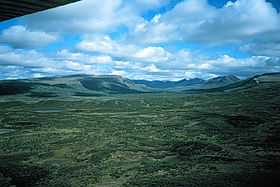Level Mountain
| Level Mountain | |
|---|---|
|
A U-shaped valley of Level Mountain with extensive elevated plateau in the foreground. | |
| Highest point | |
| Peak | Meszah Peak |
| Elevation | 2,190 m (7,190 ft) |
| Coordinates | 58°25′0″N 131°21′0″W / 58.41667°N 131.35000°W |
| Dimensions | |
| Area | 1,800 km2 (690 sq mi) |
| Geography | |
|
<div style="padding:2px 2px 5px 2px;> 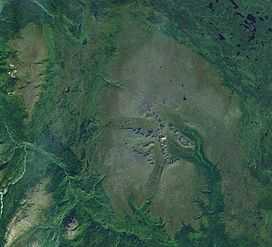 Satellite image of Level Mountain (middle) and Heart Peaks (upper-left corner). This image is approximately 80 km E-W. | |
| Country | Canada |
| Province | British Columbia |
| Range coordinates | 58°23′46″N 131°24′06″W / 58.3961°N 131.4017°WCoordinates: 58°23′46″N 131°24′06″W / 58.3961°N 131.4017°W [1] |
| Parent range | Nahlin Plateau (western Stikine Plateau) |
| Geology | |
| Orogeny | Volcanism |
| Period | Miocene-to-Holocene?[2] |
| Type of rock | Shield volcano |
Level Mountain is a massive shield volcano in Cassiar Country, northwestern British Columbia, Canada, located just southeast of Callison Ranch, southwest of Dease Lake and about 50 km (31 mi) north of Mount Edziza. It lies on the Nahlin Plateau, comprising a series of buttes and ridges. The shield is lightly glaciated, as compared to the Coast Mountains just to the west. The only named summit of Level Mountain is Meszah Peak on the north side of the shield with an elevation of 2,190 m (7,185 ft), making it the highest point of Level Mountain.[3] Immediately to the west, however, are the Heart Peaks, a related volcanic range just east of the Sheslay River, which is the edge of the Nahlin Plateau.
Level Mountain rises above adjacent forested lowlands and undulating alpine areas surround the steeper central peaks. Streams that originate from these peaks drain across the Nahlin Plateau.
Biology
Level Mountain contains a large variety of species. In 1978, more than 400 caribou were estimated on Level Mountain but the herd was thought to be decreasing because of poor recruitment. Calf percentages averaged less than 10%. Approximately 350 caribou were counted in 1980, but only half that number were actually estimated. Wolf density was estimated at about 1/100 km2, and was thought to be similar to the initial density of the 40 km (25 mi) long Horseranch Range to the northeast. Wolf predation is considered to be an instrumental factor in producing the current pattern of caribou habitat use. Wolves were most commonly observed in 1980 in the valleys, but mountainous areas were also used for denning and hunting. Grizzly bears were also common in the mountainous portions of the Level Mountain Range and are potentially significant predators of young caribou calves. Other hoofed mammals included mountain goat, Dall Sheep, and moose.
Geology
Origins
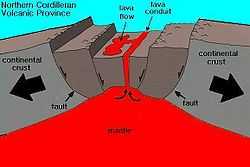
Level Mountain began forming about 14.9 million years ago and has grown steadily since then.[4] Like other volcanoes in northwestern British Columbia, Level Mountain has its origins in continental rifting—a long divergent plate boundary where the lithosphere is being pulled apart.[5] Here, the continental crust of the North American Plate is being stretched at a rate of about 2 cm (1 in) per year. This incipient rifting has formed as a result of the Pacific Plate sliding northward along the Queen Charlotte Fault, on its way to the Aleutian Trench, which extends along the southern coastline of Alaska and the adjacent waters of northeastern Siberia off the coast of Kamchatka Peninsula.[5] As the continental crust stretches, the near-surface rocks fracture along steeply dipping cracks parallel to the rift known as faults. Hot basaltic magma rises along these fractures to create passive lava eruptions, known as effusive eruptions.
The rift zone has existed for at least 20 million years, and has created a line of volcanoes called the Northern Cordilleran Volcanic Province, also called the Stikine Volcanic Belt, stretching from the Alaska-Yukon border to near Prince Rupert, British Columbia.[6] Several presently dormant volcanoes in the province are potentially active, three of them having erupted in the last few hundred years, two witnessed by First Nations and placer miners during the 18th and 19th centuries.[6][7][8] Tseax Cone, which last erupted in the 18th century, is the southernmost historically active volcano in the province, while Prindle Volcano in east-central Alaska, which erupted during the Pleistocene period, is generally considered the northernmost.[9]
Structure

Level Mountain is the most voluminous and most persistent volcano of the Northern Cordilleran Volcanic Province with an area of 1800 km2 and is the earliest locus of volcanism within the volcanic province.[2][4] More than 20 Tertiary-to-Holocene volcanic vents have been identified in the central portion of Level Mountain and on its flanks, although Holocene activity (10,000 years ago to present) remains uncertain.[2] It is straddled by two major northwest trending planar rock fractures called the King Salmon Fault and the Nahlin Fault, which were active during the Mesozoic/Cenozoic eras.[4] The history of Level Mountain records glaciation extending back to the Pliocene period which extends from 5.332 million to 1.806 million years ago", affording numerous examples of the interaction of volcanic and glacial processes.[4] Even though Level Mountain is adjacent to the broad Tuya Volcanic Field, it is not considered part of the same volcanic formation because Level Mountain is a long-lived volcano whereas the Tuya Volcanic Field consists of small volcanoes noted for having only one short eruptive event.[10]

Eruptive history
Level Mountain was formed during three phases of volcanic activity. From trace elements and isotope systematics, the origin of the lavas that form Level Mountain requires an upper mantle source for both the basaltic and the salic lavas.[4] Refractory xenocrysts (olivine, orthopyroxene, spinel) from Level Mountain basalt and spinel lherzolites from nearby vents in the Stikine Canyon and at Castle Rock support this contention.[4] The bimodal sodic alkalic lava suite at Level Mountain is typical of hotspot and continental rift volcanism with leaky transform settings.[4]
Shield volcano eruptive period
The first phase of activity resulted in the creation of the massive oval-shaped shield volcano 14.9 million years ago during the mid-Miocene period.[4] The shield volcano forms a broad cliff-bounded lava plateau, 70 km (43 mi) long and 45 km (28 mi) wide, with an average thickness of 750 m (2,461 ft) and an elevation of 1,400 m (4,593 ft) on the eroded Nahlin Plateau marking extensive Neogene regional uplift. The shield is built of four distinctive stratigraphic units dominated by 1 to 8 m thick basaltic lava flows separated by thin discontinuous breccias, sporadic tuff horizons, and local lenses of fluvial, lacustrine, and glacial sediment.[4] Ropy pahoehoe lava flows predominate over blocky aa lava flows, breccias, and tuffs, attesting to a fluid and effusive character for the volcanism.[4] Radial flow directions and quaquaversal dips suggest that most lava flows originated from central vents rather than flank vents.[4] Long masses of magmatic rock exist throughout the shield but are rare, thin, and radially oriented.[4] These long masses of magmatic rock, known as dikes, are intermittent features related to high-level volcanotectonic processes within the shield.[4]
Stratovolcano eruptive period

The near finished stages of the shield-forming phase was overlapped by another eruptive period starting 7.1 million years ago, forming a massive bimodal stratovolcano.[4] This 860 km3 stratovolcano functions as a volcanic plug centrally located atop the shield and comprises several volcanic vents, some of which were formerly more than 2,500 m (8,202 ft) in elevation.[4] The stratigraphy of the stratovolcano is complex due to the influence of adjacent vents and to the tremendous variation in the erupted magmas (oversaturated, undersaturated, peralkaline, and metaluminous).[4] Five bimodal packages of lava flows and ejecta comprise the stratovolcano.[4] Felsic compositions dominate more than 80% of the stratovolcano's volume with peralkaline volcanic rocks, trachyte and comendite being the most common.[4]
Peralkaline magmas had remarkable effects on lava flow morphology and mineralogy.[4] Low volume flows (7 km long x 3 to 8 m thick), with small-scale flow folds and lava tubes reaching 1 to 2 m in diameter and thin dikes up to 1 m (3 ft) thick, owed their fluidity to liquidus temperatures in excess of 1,200 °C and viscosities as low as 105 poise.[4] These physical properties are atypical for melts of such high silica content.[4]
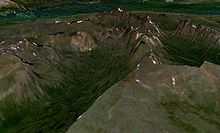
The shield-forming phase eventually ended 6.9 million years ago whereas the stratovolcano-forming phase ended 5.3 million years ago.[4] Widespread evidence for contemporaneous volcanism and glaciation is present in the upperpart of the shield and in the stratovolcano.[4] This evidence includes flat-topped, steep-sided volcanoes on the uppermost surface of the shield called tuyas and as outliers, tills and glacial erratics at the base of lava flows and tuffs, till cemented by siliceous sinter, lahars made up of till and agglomerate, volcano-glacial tuff breccias, interlayered unconsoildated fluvioglacial and tuffaceous deposits, and freshwater pillow basalts.[4] The tuyas of Level Mountain formed when magma intruded into and melted a vertical pipe in the overlying continental ice sheets that existed during this period of volcanic activity. The partially molten mass cooled as a large block, with gravity flattening its upper surface. The shield margins have been sculpted by continental ice, and its uppermost member includes volcano-glacial facies.[4] Radially directed alpine glaciers and streams have dissected the stratovolcano into a series of U-shaped valleys with intervening ridges that constitute the Level Mountain Range.[4] This and the light snowfall covering the dissected stratovolcano offers a unique opportunity to view cross sections through an effusive peralkaline volcano.[4]
Lava dome eruptive period
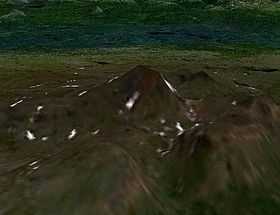
The final phase of activity constructed a series of lava domes 4.5 million years ago that post-date the alpine valley system and cut the glacially eroded core of the stratovolcano.[4] Individual lava domes have volumes up to 9.4 x 107m3 and headward erosion has further modified the volcano by incising youthful V-shaped stream canyons into the lava plateau margin.[4] This is the local expression of continuing regional uplift with canyon development on all of the adjacent major river systems, including the Stikine River with its prominent section of Tertiary basalts.[4] Lesser volcanic activity continued into the Quaternary until 2.5 million years ago when dome-forming eruptions ceased.[2][4]
See also
- Volcanology of Canada
- Volcanology of Western Canada
- List of Northern Cordilleran volcanoes
- List of volcanoes in Canada
References
- ↑ "Level Mountain Range". BC Geographical Names. Retrieved 2014-12-23.
- ↑ 2.0 2.1 2.2 2.3 "Level Mountain". Global Volcanism Program. Smithsonian Institution. Retrieved 2008-12-07.
- ↑ "Meszah Peak". BC Geographical Names. Retrieved 2014-12-23.
- ↑ 4.0 4.1 4.2 4.3 4.4 4.5 4.6 4.7 4.8 4.9 4.10 4.11 4.12 4.13 4.14 4.15 4.16 4.17 4.18 4.19 4.20 4.21 4.22 4.23 4.24 4.25 4.26 4.27 4.28 4.29 4.30 Wood, Charles A.; Kienle, Jürgen (2001). Volcanoes of North America: United States and Canada. Cambridge, England: Cambridge University Press. pp. 121, 122, 123. ISBN 978-0-521-43811-7. OCLC 27910629.
- ↑ 5.0 5.1 "Map of Canadian volcanoes". Geological Survey of Canada. 2008-02-13. Retrieved 2008-09-12.
- ↑ 6.0 6.1 "Canada Volcanoes and Volcanics". United States Geological Survey. 2006-11-09. Retrieved 2008-06-13.
- ↑ "Atlin Volcanic Field". Global Volcanism Program. Smithsonian Institution. Retrieved 2008-09-13.
- ↑ "Tseax River Cone". Global Volcanism Program. Smithsonian Institution. Retrieved 2008-09-13.
- ↑ "Map of Canadian volcanoes". Geological Survey of Canada. 2005-08-20. Retrieved 2008-09-12.
- ↑ "Documentation of a Holocene volcanic cone in the Tuya-Teslin volcanic field, northern British Columbia". Geological Survey of Canada. Retrieved 2008-12-07.
External links
| Wikimedia Commons has media related to Level Mountain. |
- Volcanoes of Canada Stikine Volcanic Belt (Level Mountain area)
- Catalogue of Canadian volcanoes - Level Mountain
- "Level Mountain Range". BC Geographical Names.
| ||||||||||||||||||
